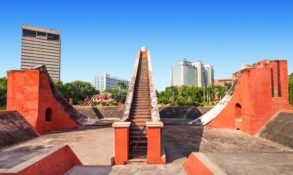
Located in the regal city of Jaipur near the City Palace, Jantar Mantar is the world’s largest astronomical stone observatory. Jantar Mantar in Jaipur was also on the UNESCO list of World Heritage Sites, owing to its rich cultural, heritage and science interest. This ancient study was designed by Raja Sawai Jai Singh in 1727-33 and boasts nineteen instruments made of stone and brass. The intelligent design and placement of these instruments allowed the observers to notice with their naked eye alone the location of the heavenly bodies. Time has failed to lay dust on this masterpiece of engineering and it still works just as well as it used to in the old days.
The main aim of building this large observatory was to research and gather information on space and time. The instruments here contribute to the Egyptian study of Ptolemaic astronomy and adopt three classical celestial coordinates to chart heavenly bodies’ locations, namely the local horizon-zenith system, the equatorial system, and the ecliptic system. Another fact which makes this destination special is the location of the world’s largest sundial. The Jaipur Observatory is part of a series of five other such Observatories designed by Raja Jai Singh in New Delhi, Ujjain, Varanasi and Mathura.